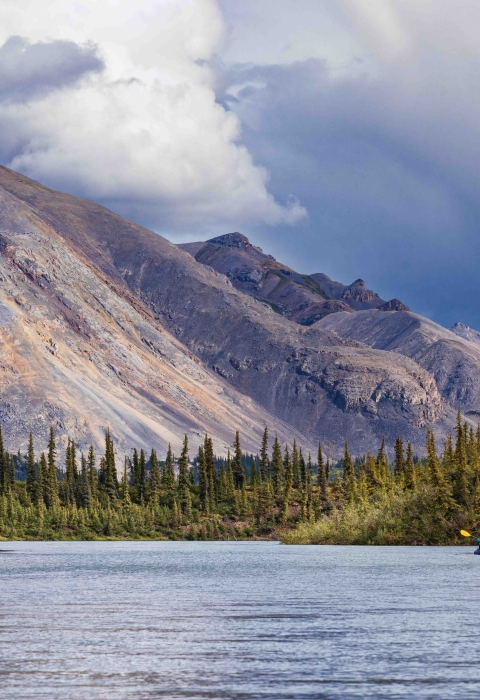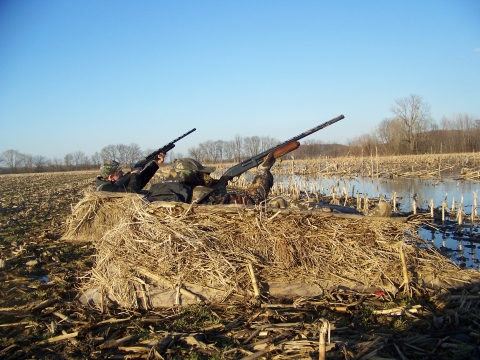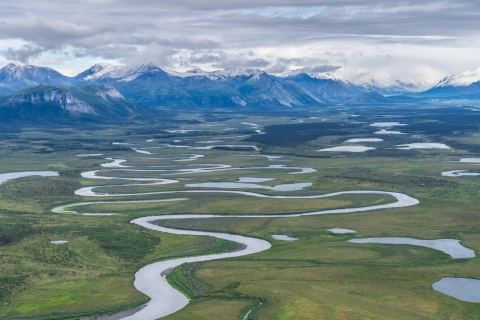Steve Berendzen floated above the sea floor, watching his snorkeling partner examine the coral reef while keeping an eye on the dozens of sharks around them. The water around Howland Island National Wildlife Refuge was so clear, the bright sun above illuminated the busy reef below. As the sunlit water around him grew dark, two ocean going manta ray began to circle the two U.S. Fish and Wildlife Service biologists. Face-to-face with one of the largest creatures he’d ever encountered (ocean going or pelagic manta rays can have a fin-span of up to 26 feet!), Berendzen’s only thought was of the magnificence of the animals that danced around him – curious about their land-based visitors. Working for the U.S. Fish and Wildlife Service for 39 years, this would not be the last time he came face-to-face with a large animal, but it was Berendzen’s favorite and first working for the agency.
In early 2024, Berendzen retired as the project leader for the Central Washington National Wildlife Refuge Complex. Since starting his career as a biologist in Hawai'i, Berendezen worked in five regions and at nine refuges across Washington, Alaska, Colorado, Oklahoma, Arizona and California. He also worked as a regional refuge supervisor for Montana, Wyoming and Utah. The National Wildlife Refuge System stretches from the bottom of the Mariana Trench in the Pacific Ocean to the top of the mountains of the Brooks Range in Alaska, from wide open prairies to the some of the fastest growing urban areas in the country.
Each unit of the refuge system – national wildlife refuges, marine national monuments, national monuments, conservation area conservation area
A conservation area is a type of national wildlife refuge that consists primarily or entirely of conservation easements on private lands. These conservation easements support private landowner efforts to protect important habitat for fish and wildlife and major migration corridors while helping to keep agricultural lands in production.
Learn more about conservation area , or waterfowl production area waterfowl production area
Waterfowl production areas are small natural wetlands and grasslands within the National Wildlife Refuge System that provide breeding, resting and nesting habitat for millions of waterfowl, shorebirds, grassland birds and other wildlife. Virtually all waterfowl production areas are in the Prairie Pothole Region states of Iowa, Minnesota, Montana, North Dakota and South Dakota.
Learn more about waterfowl production area – is established for a specific conservation purpose. Native wildlife, migratory birds, coral reef and even deep-sea canyons are protected by this network of public lands and waters. Key to their future is the active management by refuge managers and their teams, who implement scientifically based management strategies and work with partners to develop community-based conservation solutions.
Nature and working outdoors and with the land have always been a part of his life. Growing up on a farm in rural Missouri, Berendzen spent his youth outdoors hunting, fishing, and running trap lines. He went to University of Missouri for his undergraduate and University of Massachusetts for his graduate studies in fisheries and wildlife. He wasn’t sure where he was headed after graduation, but the opportunity arose to research endangered Hawaiian waterbirds on O'ahu, and he headed for the Pacific. As with so many folks who start their career in the federal service, Berendzen was able to take advantage of a special hiring program for students through the university’s cooperative studies program. Without this program, he would not have known about the career opportunities offered in the Service.
There are a number of ways that folks can start their careers in the Service, and from Berendzen’s perspective, internships or fellowships are a great way to get started. As a supervisor and refuge manager, Berendzen supported opportunities for folks to grow. According to those who work for him, Berendzen believes in empowering his team to make decisions and share their input. When asked what one of his most important lessons is from 39 years in conservation, Berendzen says it is to take the time, and be willing, to listen to others and understand their perspective on conservation and their values. “He has a passion for mammals and a very humble approach to refuge management, said Trina Staloch. “He’s been recognized for this approach not just by those of us who’ve worked for him, but for anyone he’s worked with throughout the years.”
This foundational principal is one of the reasons he was selected as the 2021 National Wildlife Refuge Manager of the Year by the National Wildlife Refuge Association. The award recognizes the outstanding accomplishments of refuge managers who protect and manage national wildlife refuges. At the time, Berendzen managed Arctic National Wildlife Refuge, the largest and northernmost refuge in the country. As manager, he oversaw 19 million acres, 8 million of which are designated wilderness and balanced multiple designated purposes for the refuge, including the implementation of a new legally mandated oil and gas program.
According to Berendzen, the Arctic National Wildlife Refuge is the crown jewel of the National Wildlife Refuge System – and of our wilderness protected areas. Hiking those mountains, you feel small and insignificant surrounded by all that majesty and beauty, recollected Berendzen. But many wilderness areas are facing challenges as the changing climate brings impacts that conservationists couldn’t have predicted when the wilderness act became law in 1967. For example, anything that leaves a human impact is typically prohibited in a wilderness area wilderness area
Wilderness areas are places untamed by humans. The Wilderness Act of 1964 allows Congress to designate wilderness areas for protection to ensure that America's pristine wild lands will not disappear. Wilderness areas can be part of national wildlife refuges, national parks, national forests or public lands managed by the Bureau of Land Management.
Learn more about wilderness area . However, as ecosystems shift or invasive species invasive species
An invasive species is any plant or animal that has spread or been introduced into a new area where they are, or could, cause harm to the environment, economy, or human, animal, or plant health. Their unwelcome presence can destroy ecosystems and cost millions of dollars.
Learn more about invasive species move into previously unoccupied habitats, wilderness areas may need human management actions to retain the areas wilderness character.
Using the best available science to plan for the future is one of the ways managers have adapted to long-term challenges and impacts over the course of Berendzen’s career. Things like comprehensive conservation plans. CCPs ensure that each national wildlife refuge national wildlife refuge
A national wildlife refuge is typically a contiguous area of land and water managed by the U.S. Fish and Wildlife Service for the conservation and, where appropriate, restoration of fish, wildlife and plant resources and their habitats for the benefit of present and future generations of Americans.
Learn more about national wildlife refuge unit is managed to fulfill the purpose(s) for which it was established. Completed CCPs allow refuge managers to take actions that support State Wildlife Action Plans, which improve the condition of habitats and benefit wildlife. The current generation of CCPs focuses on individual national wildlife refuge actions that contribute to larger, landscape-level goals identified through the Landscape Conservation Design process. Ultimately, the work of the National Wildlife Refuge Systems and refuge managers ensure that future generations will be able to benefit from the amazing natural resources that define America.
It tells you a lot about a person, the things they hold onto as important. When asked for his favorite memories throughout his career, Berendzen chose to share ones where wildlife surprised him with their intelligence and curiosity and where the immensity of the natural places we protect made him feel small. That getting anything done starts with valuing people and hearing what they have to say. From those that know him, his passion, dedication and interest in wildlife have resulted in a career that made a difference for wildlife and those that worked with him.
“One of the best things about working for this agency has been the opportunity to work in so many different places,” said Berendzen. “There are so many different job opportunities or job series that [anyone] should have an opportunity to find a good fit in the way of a job series. I would recommend working for the Service to any person that has a passion for nature and an interest in the work.”







